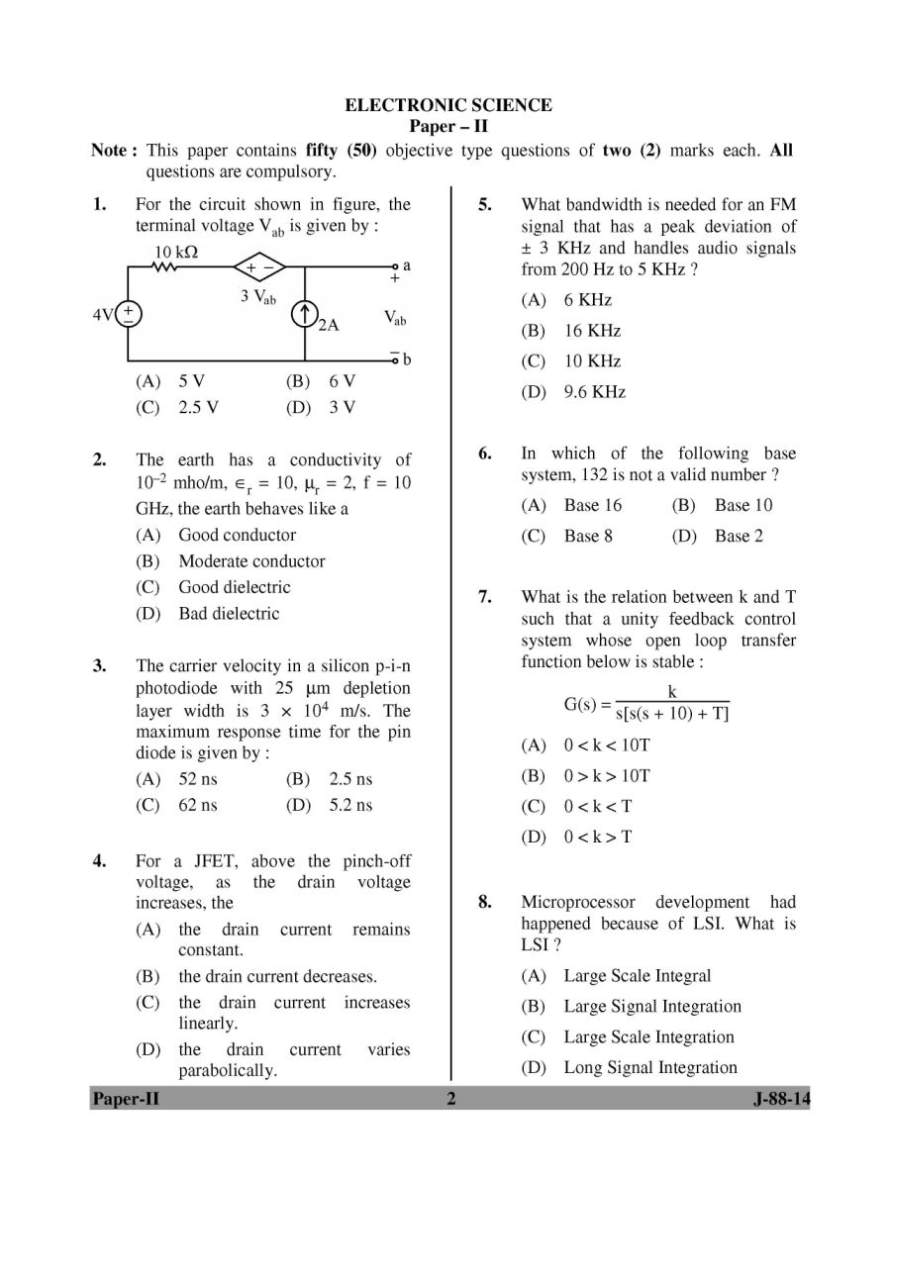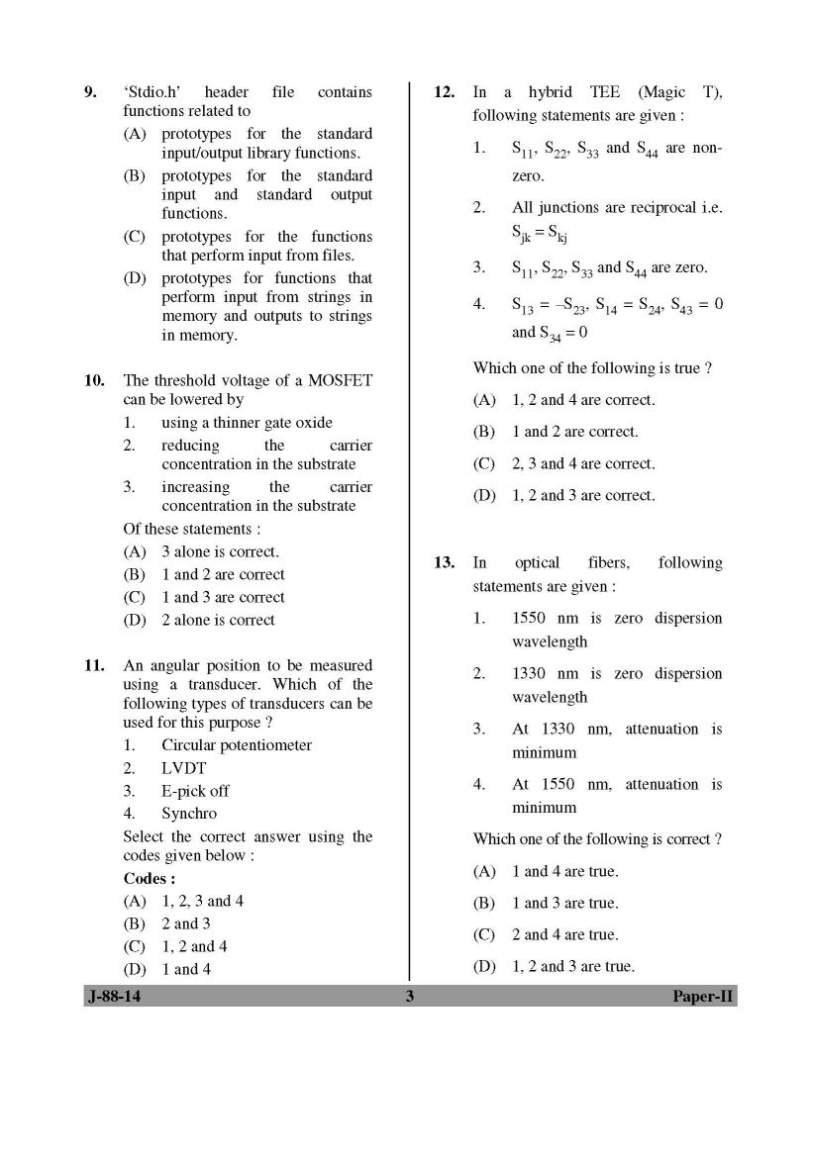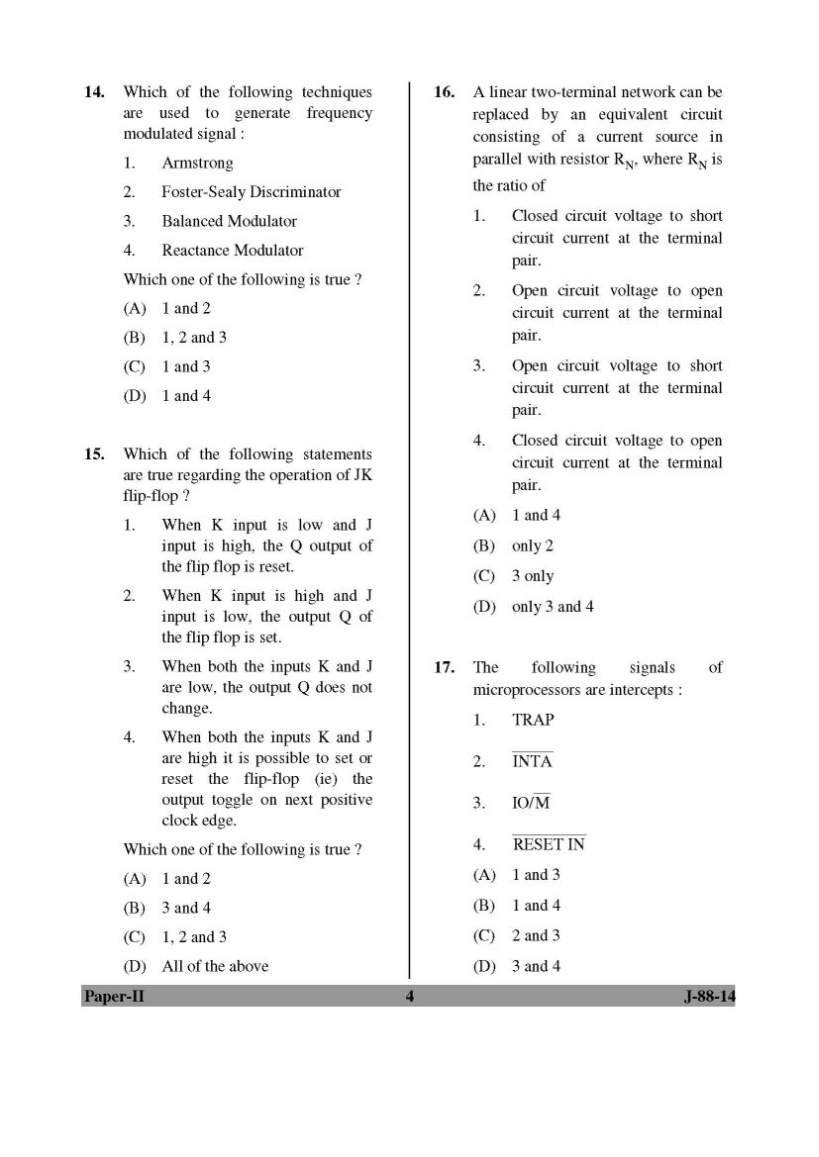| Re: UGC NET Exam for Electronics eligibility
The UGC NET Exam is conducted to determine eligibility for college & university level lectureship and for award of Junior Research Fellowship (JRF) for Indian nationals in order to ensure minimum standards for the entrants in the teaching profession and research.
Eligibility:
The applicant must have secured at least 55% marks (without rounding off) in Master’s Degree OR equivalent examination from universities/institutions recognized by UGC
AGE LIMIT
For Junior Research Fellowship: Not more than 28 years
Lectureship: There is no upper age limit for applying for lectureship eligibility
Electronic Science paper pattern:
There will be two question papers UGC NET Electronics:
Paper II will cover 50 Multiple Choice Questions ( Multiple choice, Matching type, True / False, Assertion-Reasoning type ) carrying 100 marks and UGC NET Electronics
Paper III will have two Parts-A and B.
Part-A
This will have 10 short essay-type questions ( 300 words ) carrying 16 marks each. There will be one question from each unit with internal choice from the same unit. Total marks will be 160.
Part-B will be compulsory and questions will be set from Unit-I to Unit-X. The candidate will attempt only one question from Part-B ( 800 words ) carrying 40 marks. Total marks of UGC NET Electronics Paper III will be 200.
Syllabus UGC NET Electronics Paper II and III ( Part A & B ) :
Unit – I :
Electronic Transport in semiconductor, PN Junction, Diode equation and diode equivalent circuit. Breakdown in diodes, Zener diodes, Tunnel diode, Semiconductor diodes, characteristics and equivalent circuits of BJT, JFET, MOSFET, IC fabrication-crystal growth, epitaxy, oxidation, lithography, doping, etching, isolation methods, metalization, bonding, Thin film active and passive devices.
Unit-II :
Superposition, Thevenin, Norton and Maximum Power Transfer Theorems, Network elements, Network graphs, Nodal and Mesh analysis, Zero and Poles, Bode Plots, Laplace, Fourier and Z – transforms. Time and frequency domain responses. Image impedance and passive filters. Two – port Network Parameters. Transfer functions, Signal representation. State variable method of circuit analysis, AC circuit analysis, Transient analysis.
Unit – III :
Rectifiers, Voltage regulated ICs and regulated power supply, Biasing of Bipolar junction transistors and JFET. Single stage amplifiers, Multistage amplifiers, Feedback in amplifiers, oscillators, function generators, multivibrators, Operational Amplifiers ( OP AMP ) – characteristics and Applications, Computational Applications, Integrator, Differentiator, Wave shaping circuits, F to V and V to F converters. Active filters, Schmitt trigger, Phase locked loop.
Unit – IV :
Logic families, flip – flops, Gates, Boolean algebra and minimization techniques, Multivibrators and clock circuits, Counters-Ring, Ripple. Synchronous, Asynchronous, Up and down shift registers, multiplexers and demultiplexers, Arithmetic circuits, Memories, A/D and D/A converters.
Unit – V :
Architecture of 8085 and 8086 Microprocessors, Addressing modes, 8085 instruction set, 8085 interrupts, Programming, Memory and I/O interfacing, Interfacing 8155, 8255, 8279, 8253, 8257, 8259, 8251 with 8085 Microprocessors, Serial communication protocols, Introduction of Microcontrollers ( 8 bi t) – 8031 / 8051 and 8048.
Unit – VI :
Introduction of High – level Programming Language, Introduction of data in C. Operators and its precedence, Various data types in C, Storage classes in C, Decision-making and forming loop in program, Handling character, Arrays in C, Structure and union, User defined function, Pointers in C, Advanced pointer. Pointer to structures, pointer to functions, Dynamic data structure, file handling in C, Command line argument, Graphics-video modes, video adapters, Drawing various objects on screen, Interfacing to external hardware via serial / parallel port using C, Applying C to electronic circuit problems. Introduction to object-oriented Programming and C++.
Introduction of FORTRAN language, programming discipline, statements to write a program, intrinsic functions, integer-type data, type statement, IF statement, Data validation, Format-directed input and output. Subscripted variables and DO loops. Array, Fortran Subprogram.
Unit – VII :
Maxwell’s equations, Time varying fields, Wave equation and its solution, Rectangular waveguide, Propagation of wave in ionosphere, Poynting vector, Antenna parameters, Half-wave antenna, Transmission lines, Characteristic of Impedance matching, Smith chart, Microwave components-T, Magic – T, Tuner. Circulator isolator, Direction couplers, Sources-Reflex Klystron, Principle of operation of Magnetron, Solid State Microwave devices; Basic Theory of Gunn, GaAs FET, Crystal Defector and PIN diode for detection of microwaves.
Unit – VIII :
Basic principles of amplitude, frequency and phase modulation, Demodulation, Intermediate frequency and principle of superheterodyne receiver, Spectral analysis and signal transmission through linear systems, Random signals and noise, Noise temperature and noise figure. Basic concepts of information theory, Digital modulation and Demodulation; PM, PCM, ASK, FSK, PSK, Time-division Multiplexing, Frequency-Division Multiplexing, Data Communications-Circuits, Codes and Modems. Basic concepts of signal processing and digital filters.
Unit – IX ( a ) :
Characteristics of solid state power devices – SCR, Triac, UJT, Triggering circuits, converters, choppers, inverters, converters. AC-regulators, speed control of a.c. and d.c. motors.
Unit – IX ( b ) :
Optical sources – LED, Spontaneous emission, Stimulated emission, Semiconductor Diode LASER, Photodeteetors – p – n photodiode. PIN photodiode, Phototransistors, Optocouplers, Solar cells, Display devices, Optical Fibres-Light propagation in fibre, Types of fibre, Characteristic parameters, Modes, Fibre splicing, Fibre optic communication system-coupling to and from the fibre, Modulation, Multiplexing and coding, Repeaters, Bandwidth and Rise time budgets.
Unit – X ( a ) :
Transduces – Resistance, Inductance Capacitance, Peizoelectric, Thermoelectric, Hall effect, Photoelectric, Techogenerators, Measurement of displacement, velocity, acceleration, force, torque, strain, speed and sound temperature, pressure, flow, humidity, thickness, pH, position.
Measuring Equipment-Measurement of R, L and C, Bridge and Potentiometers, voltage, current, power, energy, frequency / time, phase, DVMs, DMMs, CRO, Digital storage oscilloscope, Logic probes, Logic State Analyser, Spectrum Analyzer, Recorder, Noise and Interference in instrumentation, Instrumentation amplifiers, Radio Telemetry.
Analytical Instruments – Biomedical instruments – ECG, blood pressure measurements, spectrophotometers, Electron Microscope, X-ray diffractometer.
Unit – X ( b ) :
Open – loop and close-loop control system. Error amplifier, on – off controller, Proportional ( P ), Proportional-Integral ( PI ), Proportional – Derivative ( PD ), PID controllers, Dynamic Behaviour of control systems-servomechanism characteristics parameters of control systems-Accuracy, Sensitivity, Disturbances, Transient response, Stability, Rputh-Hurwitz criterion, Bode plots, Nyquist criterion, Controlling speed. Temperature and position using analog / digital control circuits.
|




